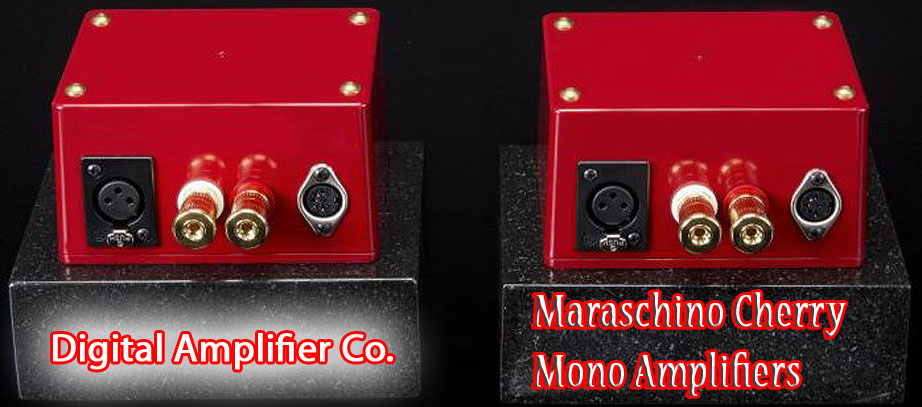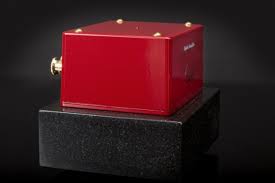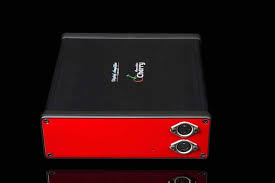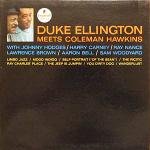Digital Amplifier Co. Maraschino Cherry Amplifier

 Despite some chuffing from the more hidebound corners of the audio world, class ‘D’ or ‘switching’ amplifiers have arrived in a big way over the past decade, and they look to have staying power. Having taken over large swaths of the home theatre market, largely due to their energy efficiency and packaging advantages, they are now being employed – with at least cautious enthusiasm – by some of the most respected high-end two-channel names in our hobby. While Audio Research hasn’t abandoned its classic tubes, and MBL still makes massive class A/B powerhouses, both companies have now joined the ranks of manufacturers offering products that employ switching, a strong sign that class D amps are a rapidly maturing technology. They’re refined enough now that they’ve become acceptable option to at least some people in the audiophile market, a crowd that consists of technologically conservative late-adopters if ever there was one.
Despite some chuffing from the more hidebound corners of the audio world, class ‘D’ or ‘switching’ amplifiers have arrived in a big way over the past decade, and they look to have staying power. Having taken over large swaths of the home theatre market, largely due to their energy efficiency and packaging advantages, they are now being employed – with at least cautious enthusiasm – by some of the most respected high-end two-channel names in our hobby. While Audio Research hasn’t abandoned its classic tubes, and MBL still makes massive class A/B powerhouses, both companies have now joined the ranks of manufacturers offering products that employ switching, a strong sign that class D amps are a rapidly maturing technology. They’re refined enough now that they’ve become acceptable option to at least some people in the audiophile market, a crowd that consists of technologically conservative late-adopters if ever there was one.
Whether or not switching amplifiers have become fully competitive with traditional class A and A/B designs is still a hotly debated topic, but the debate seems to be shifting away from the initial “hell no, never” towards “maybe” and even “I heard one and it sounded pretty darned good.”
The Digital Amplifier Company
The Digital Amplifier Company (DAC) is unusual in that it has developed it’s own switching amplification technology from scratch, builds everything in-house in the United States, and only makes amplifiers. They don’t even make a pre-amp, just amplifiers. Their original technology was designed for and used by other manufacturers, often for computer related applications rather than hi-fi.
Unlike many manufacturers who’ve abandoned the term in favor of “switching”, DAC still proudly calls their amps “Digital” though there does not appear to actually be anything digital in the signal chain. I suppose this makes sense given the name of the company. There is something to be said for an outfit so dedicated to a core technology that they only do one thing. There is no question where their attention is focused.
The Maraschino Amplifiers
 The Digital Amplifier Company’s Maraschino mono amplifiers are very small: only about six inches cubed. They are small red metal boxes mounted on heavy black granite bases with marble or aluminum optional. DAC claims the base improves vibration damping. With the bases (and excluding the power supply) they weigh eight pounds each. I didn’t dismantle them, but I suspect that without the granite the amplifiers themselves probably don’t weigh more than a pound or two. Each unit has one red LED on top to indicate that they’re powered up. In the back there is one XLR input, a connection for the separate power supply, and a pair of high-quality gold-plated binding posts. A pair of RCA to XLR conversion adaptors was supplied with the review sample to allow the use of single ended cables. Fit and finish on the amplifier unit is very nice. The paint, in particular is very nicely applied lacquer. The retail price for the basic version that I reviewed is currently $2,900. Options, which include an upgraded power supply, aluminum bases, binding posts, and power cords can push the price up by almost a grand.
The Digital Amplifier Company’s Maraschino mono amplifiers are very small: only about six inches cubed. They are small red metal boxes mounted on heavy black granite bases with marble or aluminum optional. DAC claims the base improves vibration damping. With the bases (and excluding the power supply) they weigh eight pounds each. I didn’t dismantle them, but I suspect that without the granite the amplifiers themselves probably don’t weigh more than a pound or two. Each unit has one red LED on top to indicate that they’re powered up. In the back there is one XLR input, a connection for the separate power supply, and a pair of high-quality gold-plated binding posts. A pair of RCA to XLR conversion adaptors was supplied with the review sample to allow the use of single ended cables. Fit and finish on the amplifier unit is very nice. The paint, in particular is very nicely applied lacquer. The retail price for the basic version that I reviewed is currently $2,900. Options, which include an upgraded power supply, aluminum bases, binding posts, and power cords can push the price up by almost a grand.
 The separate power supplies – one for each amp – are smallish rectangular plastic boxes with an umbilical cord that attaches to the amp and an IEC receptacle for the power cord of your choice. On the version I received, neither the amp nor the power supply had an on/off switch, but a newer, optional version of the power supply does have one. The power supply seems ruggedly built, but it isn’t going to win any design awards. It’s just plain heavyweight black and grey plastic. Then again, it’s probably going to spend most of its life behind a cabinet somewhere, so aesthetics probably aren’t critical here. In my review sample, output power is stated at 250 watts into 4 ohms, or about 140 watts into 8 ohms. The optional power supply, which was not provided for the review, offers a significant boost in output power as well as an on/off switch.
The separate power supplies – one for each amp – are smallish rectangular plastic boxes with an umbilical cord that attaches to the amp and an IEC receptacle for the power cord of your choice. On the version I received, neither the amp nor the power supply had an on/off switch, but a newer, optional version of the power supply does have one. The power supply seems ruggedly built, but it isn’t going to win any design awards. It’s just plain heavyweight black and grey plastic. Then again, it’s probably going to spend most of its life behind a cabinet somewhere, so aesthetics probably aren’t critical here. In my review sample, output power is stated at 250 watts into 4 ohms, or about 140 watts into 8 ohms. The optional power supply, which was not provided for the review, offers a significant boost in output power as well as an on/off switch.
DAC claims the Maraschinos are 96% efficient, meaning that 96% of power consumption makes it out the speaker taps as signal power, and they do this with effectively no generated heat. For those of us using more antiquated technology this feature alone is a bit of a revelation. My main amplifier is a Cary V12r that makes 100 watts at 8 ohms in ultra-linear out of a dozen 6550 vacuum tubes. My amplifier burns so much energy as heat that you can close the vents at that end of the room and still be warm in winter. If you tried to stay warm with the Maraschinos during a cold snap you’d freeze to death.
The Maraschinos also claim effectively flat frequency response well beyond human hearing into either a four or eight Ohm load. At a dip to 2 Ohms, according to DAC’s own literature, roll off is steeper starting at about 20 kHz. During my listening I never encountered any audible treble anomalies, though my Verity Fidelio Encores are a pretty easy load, so I wouldn’t have expected any.
These are also the quietest amplifiers I’ve ever had in my house. Between tracks, the Maraschinos make absolutely no sound: no soft background static, no hum, nothing. This seemed noteworthy considering I had them paired with a tubed pre-amp and phono-stage. My own amplifier in the same setup makes consistent if minor low-level background noise, so this was a pleasant change.
Operation
Running the Maraschinos was straightforward. Hookup some interconnects and speaker cables, plug them in, and play music. They’re about as simple an amplifier as you’re likely to encounter.
My only operational issue with these amps was the lack of a power switch. DAC’s explanation is that a switch is unnecessary because the amps go to sleep after eight minutes without a signal. But the manual also states that it’s preferred to turn on the Maraschinos after the pre-amp is powered up. Turning on my pre-amp with the Maraschinos already running resulted in a sharp pop through my speakers that the manual warns can actually damage the amplifier (let alone the speakers). With an all solid-state rig where you can leave the pre-amp on all the time this might not be a problem, but I run a tubed pre-amp and I definitely turn it off when not in use. It’s thunderstorm season here in Pennsylvania, and I have a toddler. Those are two good reasons to not leave tubes running hot unattended. I had to unplug the Maraschinos every time I wanted to shut off my pre-amp, which I think of as akin to dismantling part of my system. As I mentioned earlier, the upgraded power supply does have a switch, but in a $2900 product you shouldn’t have to buy a $400 option to get something so basic.
Otherwise, the Maraschinos just sit there, which is a good physical quality in an amplifier. With no moving parts – not even a switch – there’s really nothing to go wrong with them and they proved perfectly reliable during the review period.
Listening
 The first time I listened to a switching amplifier at length I was visiting an Audio Research dealer where I had the opportunity to hear their DSi200 hybrid integrated amp driving a pair of Vandersteen Treos. My recollection was that a) it didn’t sound like an Audio Research amp and, b) it was very fast, a little bright, and somewhat analytical, at least compared to other ARC products. While it wasn’t quite my cup of tea I thought it was a pretty good listen. That visit piqued my interest enough that I was willing to give a class D amplifier a try. When the opportunity to review the Maraschinos came along it seemed like it was time to take the plunge.
The first time I listened to a switching amplifier at length I was visiting an Audio Research dealer where I had the opportunity to hear their DSi200 hybrid integrated amp driving a pair of Vandersteen Treos. My recollection was that a) it didn’t sound like an Audio Research amp and, b) it was very fast, a little bright, and somewhat analytical, at least compared to other ARC products. While it wasn’t quite my cup of tea I thought it was a pretty good listen. That visit piqued my interest enough that I was willing to give a class D amplifier a try. When the opportunity to review the Maraschinos came along it seemed like it was time to take the plunge.
With a healthy output of 140 watts per channel into eight ohms, the Maraschinosare quite muscular. Driving my Verities, the bass was punchy, defined, and very well controlled; maybe not the deepest I’ve ever heard in my system (that award goes to the Wells Audio Akasha) but still solid. These amps should have no trouble driving any reasonable speaker load.
With a nonexistent noise floor, they really show off their frequency extension well, even at modest volumes. Playing quietly in the evenings, after the baby has gone to bed, they still allow most of the music to be heard clearly. Turned up and rocking, these things really get into the furthest corners of most recordings with a tremendous amount of detail.
In the past five or six years, in addition the Cary amp I’m currently using, I’ve had amplifiers from Denon, Rotel, Musical Fidelity, Grommes, Wells Audio and a few others in my system. Some were obviously better than others, but the differences were in refinement, scale, resolution, sound-staging and extension. I might swap out an amp and hear significantly more resolution, detail and depth, or a bigger soundstage, but none of them changed the essential qualities of a recording. A Van Gelder recording always sounds like a Van Gelder recording.
The Maraschinos have a dramatically different sound than any other amplification I’ve had in my system. There is nothing remotely harsh or bright about them, in fact they are close to being the most fluid sounding amps I’ve used. But to my ears and in the context of my system, they’re a little too smooth. They have tons of clean detail, but they buff over some of the texture and tone colors that are in such evidence with my own amp. I wouldn’t go so far as to say they sound bleached, but the Maraschinos did not – again, IN MY SYSTEM – deliver all of the rich palate that I expect from certain recordings.
 A good example is Coleman Hawkins’ tenor horn on the Duke Ellington Meets Coleman Hawkins on 45 RPM vinyl. With my V12 there’s a visceral ripping quality of the reed vibrating and the brass bell reverberating that sounds like the instrument is being played right in front of you. The Maraschinos ever-so-slightly sanded the edges off those midrange dynamics enough to diminish the vibrancy of the recording.
A good example is Coleman Hawkins’ tenor horn on the Duke Ellington Meets Coleman Hawkins on 45 RPM vinyl. With my V12 there’s a visceral ripping quality of the reed vibrating and the brass bell reverberating that sounds like the instrument is being played right in front of you. The Maraschinos ever-so-slightly sanded the edges off those midrange dynamics enough to diminish the vibrancy of the recording.
To be sure, there’s an argument to be made that the texture and color that I hear and love in my tube amplifier is the result of distortion and unnatural tube warmth, and that might be true to a point. But those tubes provide a vibrant and, to my ears, realistic recreation of instruments.
The Maraschinos are softer and less colorful, yet more detailed at the same time. Of course, as has often been noted, the mid-range is where the music lives, so a dramatic modification there will change the listening experience of the entire recording. The Maraschinos have their own perspective: They tilt heavily towards cool detail at the expense of vivid, tactile color. I’ll let others judge whether it’s an accurate reproduction of any given recording, but it certainly is different.
Moving up the frequency ladder, what seems like a modification in the mid-range becomes a real asset in the treble. As mentioned earlier, these amplifiers have very flat response high into the frequency spectrum. With an eight ohm load they’re actually tipped up a little all the way to 60 kHz. Mercifully, that extension is impeccably clean and clear, with no hint of tizziness or hardness that could lead to listener fatigue. A ride cymbal tapped modestly at the back of a stage comes through with perfect clarity, and violins, which can sound strident on even some of the best recordings, are wonderfully fluid.
 Violinist Jonathan Crow’s album Mozart the Mason, features Mozart’s trio Divertimento in E-flat K 563. It’s among the most beautiful and complete pieces of music in the classical repertoire. The Maraschinos present Crow’s violin with silky smoothness, even at the highest notes. And with no roll-off to speak of, a nonexistent noise floor, and detailed presentation, that treble is audibly all there. As I’ve careened into my mid-forties I’ve become particularly sensitive to over-bright treble and the Maraschinos own some of the nicest sounding upper registers I’ve had the pleasure of listening to.
Violinist Jonathan Crow’s album Mozart the Mason, features Mozart’s trio Divertimento in E-flat K 563. It’s among the most beautiful and complete pieces of music in the classical repertoire. The Maraschinos present Crow’s violin with silky smoothness, even at the highest notes. And with no roll-off to speak of, a nonexistent noise floor, and detailed presentation, that treble is audibly all there. As I’ve careened into my mid-forties I’ve become particularly sensitive to over-bright treble and the Maraschinos own some of the nicest sounding upper registers I’ve had the pleasure of listening to.
Soundstaging is also good, with audible spatial cues and decent front to back layering. Their low noise floor surely augments their ability to create realistic representation of space and image clarity. On the other hand, in my system they didn’t recreate the physical, three-dimensional image of individual performers as well as the V12, but then that’s a trick my amp excels at.
Taken as a whole, I found the Maraschino’s presentation to be coherent, refined, powerful when the music required it, and delicate when things quieted down. They have a very different presentation than I’m used to with my own amplifier, particularly in the midrange. Within the context of their unique sound I found them to be particularly good with classical music where the superlatively clean treble extension banished nasty screeching on all but the most poorly recorded albums.
Their unique take on mid-range notwithstanding, these amplifiers have some really fine attributes. Once I got used to their sound they really were quite enjoyable to listen to. If you like their sound – and I would encourage a demo to see if you do – the Maraschinos offer some outstandingqualities.
Other Noteworthy Things
We’re all in this hobby for great sound, of course, but there is another positive element to the Maraschinos that’s worth discussing: Their size. Audiophiles seem to be conditioned to think that an amplifier’s performance is directly related to the amount of time spent at the chiropractor after movingit around. A good deal of our beloved gear is enormous, very heavy, and unwieldy. I personally have cut myself on jagged heat sinks on more than one occasion.
By comparison, the Maraschinos are tiny little things.As I mentioned earlier, they’re six inches cubed, weighing in at eight pounds each. I reviewed a pair of speaker cables last year that weighed more than one of these amps. In some of their literature DAC describes them as desktop amplifiers, but given their power capabilities they’re clearly more than that. Their diminutive stature (along with their cool operating temps) opens up a lot of options for placement in, or even under, furniture. Their size makes them incredibly practical for people who crave good sound but have limited space, bossy wives, or any of the other factors that conspire to prevent audiophiles from installing 100 lb. mono blocks in the living room.
The Maraschinos make a very compelling case for equipment that won’t take over the entire house. For those who compete for space with other household priorities (who needs a sofa anyway?)the Maraschinos can be unobtrusively integrated into family living, and there’s real value in that.
Conclusions
 As I write this I’m listening to the 1999 Schema Records reissue of Karl Drewo’s Clap Hands Here Comes Charlie, a terrific sounding CD. Originally released in 1961 on the German Metronome label, Clap Hands was likely recorded by the brilliant engineer Wolfgang Hirshmann*. The soundstage is enormous, the presentation is clean and clear, and the piano – while maybe a bit too closely mic’d – has power, resonance, and clarity on the chords that’s as good as I’ve ever heard in my system. It’s a recording that I love to listen to with my own amplifier.
As I write this I’m listening to the 1999 Schema Records reissue of Karl Drewo’s Clap Hands Here Comes Charlie, a terrific sounding CD. Originally released in 1961 on the German Metronome label, Clap Hands was likely recorded by the brilliant engineer Wolfgang Hirshmann*. The soundstage is enormous, the presentation is clean and clear, and the piano – while maybe a bit too closely mic’d – has power, resonance, and clarity on the chords that’s as good as I’ve ever heard in my system. It’s a recording that I love to listen to with my own amplifier.
I also really enjoyed listening to Clap Hands through the Maraschinos, though they give the performancea different emphasis. The bass is tighter and with more punch, and the entire spectrum has a silky smooth delivery. They don’t have the burst of tone colors I’m used to with tubes, but with their detail and extension they nevertheless deliver a compelling musical experience.
The Maraschinos do sound different than any other amp I’ve had in my system, but theyhave some truly fine qualitiesthat are worth hearing. Combined with an easy to live with physical package, they might just be what you’re looking for.
*Musical Notes.
With respect to the Karl Drewo recording, the CD doesn’t actually list Hirshmann as the engineer, and an online search couldn’t find any confirmation, but the album features pianist Francy Boland and given that it was recorded in Europe in 1961, Boland’s regular association with Hirshmann, and the stellar sound quality, I’m going out on a limb and crediting the recording. If anyone has any more detailed information I’d be glad to hear it. Hirshmann’s jazz recordings are some of the best I own and include Sahib Shihab’s Seeds as well as titles by Johnny Griffin, Lalo Schifrin, Yusef Lateef, and Eddie Lockjaw Davis.
Hirshmann also recorded an album for Boland and drummer Kenny Clarke titled The Golden Eight, which was released on Blue Note in 1961(and which also includes Drewo). To the best of my knowledge it’s the only full Blue Note album of the period that wasn’t recorded by Rudy Van Gelder. Licensing issues have kept it from being widely re-released making it an under-heard oddball, but both the music and the recording are first-rate. In a stroke of luck, Music Matters is going to be re-issuing The Golden Eight on its new 33rpm vinyl series. I’ve listened to a test pressing of this record on my own system as well as one that included a Spiral Groove turntable with a Dynavector cartridge, Nagra Jazz preamp, and ARC Ref 250 amplification driving the Vandersteen Sevens, and I can say unequivocally, if you’re an audiophile and you miss this one you will regret it. It’s that good.
You’ve been warned.

greg simmons
Product Features:
Maraschino Features:
Price: $2900.00 USA
– DC coupled signal path on floating ground (no bass phase shift, flat to 0Hz)
– Much higher modulation frequency and signal bandwidth than other Class-D amplifiers
– Stable down to 1 ohm load (low output impedance over entire audio band)
– Extremely low distortion and ultra quiet idle
– Micro power auto standby
– Universal mains external (upgradeable) medical grade power supply
– WBT gold binding posts and Neutrik gold XLR input (compact RCA input adapter included)
– Small footprint with surprisingly powerful output (up to 800W)
– Extremely detailed sound without harshness
– 0.1% metal oxide resistors used throughout
– Anti-vibration GRANITE BASE on Sorbothane
– Beautiful fit and finish
– Legendary Cherry Amp sonics
– MADE IN U.S.A.
Product Specifications:
Gain: 22db
SNR: 118dB
THD+N: 0.002%
Size: 5” x 6” X 5”
Power Efficiency: 96%
Output Impedance:
Sensitivity: 2.2Vin for 200W into 4Ω
Weight:
Input Impedance: 20 kΩ, true balanced
Frequency Response: 0 Hz to >100kHz
Output Power (48V supply): 250W into 4Ω (140W into 8Ω)
Protection: Thermal, Current, Voltage, Auto-Recovery
AC power (48V supply): Universal Mains (100-270VAC, 50-60Hz)
Website: www.digitalamp.com/
Stereo Times Masthead
Publisher/Founder
Clement Perry
Editor
Dave Thomas
Senior Editors
Frank Alles, Mike Girardi, Russell Lichter, Terry London, Moreno Mitchell, Paul Szabady, Bill Wells, Mike Wright, and Stephen Yan,
Current Contributors
David Abramson, Tim Barrall, Dave Allison, Ron Cook, Lewis Dardick, John Hoffman, Dan Secula, Don Shaulis, Greg Simmons, Eric Teh, Greg Voth, Richard Willie, Ed Van Winkle, Rob Dockery, Richard Doron, and Daveed Turek
Site Management Clement Perry
Ad Designer: Martin Perry





Be the first to comment on: Digital Amplifier Co. Maraschino Cherry Amplifier